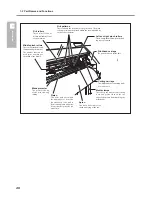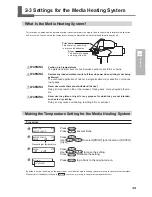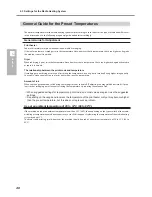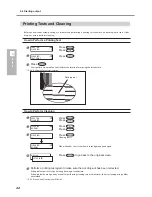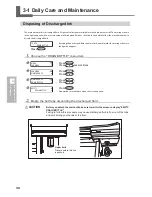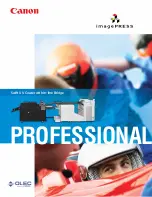
2-3 Settings for the Media Heating System
40
2
Operation
General Guide for the Preset Temperatures
The optimal temperature for the media heating system varies according to such factors as the type of media and differences
in the print mode. Use the following as a general guide and adjust accordingly.
General Guide for Adjustment
Print heater
You use this mainly to improve ink adhesion and inhibit smudging.
If the ink forms lumps or smudges, raise the temperature. Note, however, that a temperature that is too high may degrade
the media or cause it to wrinkle.
Dryer
When ink drying is poor, raise the temperature. Note, however, that a temperature that is too high may degrade the media
or cause it to wrinkle.
The relationship between the print mode and temperature
If smudging or poor drying occur even after raising the temperature, try using a print mode offering higher image quality.
Conversely, when you want to use a faster print mode, raise the temperature.
Amount of ink
When you change the amount of ink using the settings for your software RIP, adjusting this may yield better results. If prob-
lems such as smudging persist even after raising the temperature, try reducing the amount of ink.
When suggested settings for temperature, print mode, and other values are given, use the suggested
settings.
Depending on the usage environment, the temperature of the print heater or dryer may become higher
than the preset temperature, but this does not represent a problem.
Use at an ambient temperature of 20 to 32°C (68 to 90°F).
If the machine is used at an ambient temperature lower than 20°C (68°F), then depending on the type or width of the media,
wrinkling or temperature-caused unevenness may occur. If this happens, try lowering the temperature of the media heating
system by about 2°C.
To obtain stable printing results, however, the machine should be used at an ambient temperature of 20 to 32°C (68 to
90°F).
Summary of Contents for SP-300i
Page 1: ......
Page 2: ......
Page 24: ...22 ...
Page 25: ...23 1 Introduction Chapter 1 Introduction ...
Page 30: ...28 ...
Page 31: ...29 2 Operation Chapter 2 Operation ...
Page 50: ...48 ...
Page 51: ...49 3 Maintenance and Adjustment Chapter 3 Maintenance and Adjustment ...
Page 68: ...66 3 Maintenance and Adjustment ...
Page 69: ...67 4 Feature Reference Chapter 4 Feature Reference ...
Page 115: ...113 Chapter 5 What to Do If 5 What to Do If ...
Page 125: ...123 6 Specifications Chapter 6 Specifications ...
Page 133: ......
Page 134: ...R1 090619 ...

